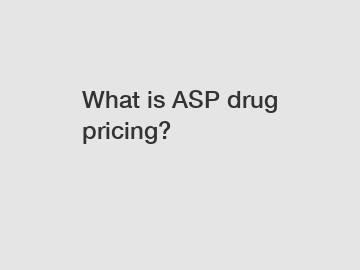What is ASP drug pricing?
If you are looking for more details, kindly visit ZASP.
In today's ever-evolving pharmaceutical landscape, ASP drug pricing is a term that holds significant importance. Standing for Average Selling Price, ASP drug pricing is a crucial reimbursement model used in the United States to determine payments for Medicare Part B-covered drugs. Understanding ASP drug pricing is essential for healthcare professionals, policymakers, and patients alike. In this blog, we will dive deep into the intricacies of ASP drug pricing to shed light on its complexities and impact on healthcare.
Unveiling the Basics.

ASP drug pricing is a metric derived from the sales data of pharmaceutical manufacturers. It represents the average price at which a drug is sold to healthcare providers such as doctors' offices and hospitals. This information is reported to the Centers for Medicare & Medicaid Services (CMS) by drug manufacturers on a quarterly basis.
Historical Perspective.
The ASP drug pricing system was introduced in 2005 as part of the Medicare Modernization Act (MMA). The main objective was to create a transparent pricing framework while ensuring fair reimbursement for providers. ASP replaced the previous Average Wholesale Price (AWP) system, which was criticized for lacking accuracy.
How is ASP Calculated?
The CMS calculates the ASP using the actual sales transaction data reported by drug manufacturers. It includes discounts, rebates, and other price concessions offered to purchasers. The ASP represents the net revenue earned by manufacturers after deducting these concessions from the product's actual sales. The CMS then updates the ASP quarterly, ensuring price accuracy.
Reimbursement Models.
ASP drug pricing directly impacts reimbursement for Medicare Part B-covered drugs. Medicare Part B covers medications administered by healthcare professionals in an outpatient or office setting. The reimbursement rates are based on a percentage of the drug's ASP. Currently, Medicare pays physicians and providers 106% of the ASP for covered drugs, effectively providing a margin to cover handling and administration costs.
Important Considerations.
Pricing Transparency and Controversies.
ASP drug pricing aims to bring transparency to drug pricing by reflecting the actual sales prices. However, controversies have emerged around certain aspects of this model. Critics argue that manufacturers may manipulate the system by offering rebates and discounts to specific groups, leading to unfairly skewed prices. Others believe that the system's reliance on self-reporting by manufacturers may hinder transparency.
Affordability and Access to Medications.
ASP drug pricing significantly affects patients' access to affordable medications. High-priced drugs can create financial barriers, especially for individuals with chronic illnesses or those reliant on multiple medications. Policymakers work continuously to strike a balance between incentivizing innovation and ensuring affordability and accessibility for all patients.
Future Perspectives.
As technology evolves, the pharmaceutical industry continues to witness innovative developments. Value-based pricing models are gaining traction, where drug pricing is linked to the treatment's overall effectiveness. While ASP drug pricing remains dominant for Medicare Part B-covered drugs, the industry may be on the cusp of adopting more sophisticated approaches to pricing pharmaceuticals.
Conclusion.
ASP drug pricing is a critical element shaping the landscape of healthcare reimbursement in the United States. By accurately reflecting actual sales prices, ASP helps ensure fairness and transparency in pricing. Understanding this pricing model is vital for healthcare professionals, policymakers, and patients to navigate the complexities of drug pricing and access to affordable medications. As medicine continues to advance, striking a balance between innovation, affordability, and accessibility will remain a focal point for the future of drug pricing.
If you are looking for more details, kindly visit our website.
For more information, please visit Road Blocker System.



